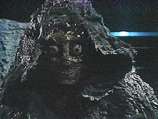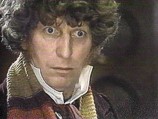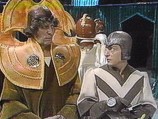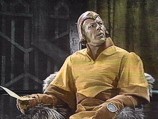 |
|
The Master
|
|
 After receiving a mysterious summons from the Time Lords, which forces him to return Sarah Jane Smith to Earth and so travel alone in the TARDIS, The Doctor experiences a premonition about the President of the Time Lords being murdered. After receiving a mysterious summons from the Time Lords, which forces him to return Sarah Jane Smith to Earth and so travel alone in the TARDIS, The Doctor experiences a premonition about the President of the Time Lords being murdered.
 The Doctor materialises the TARDIS in the cloisters area outside the Capitol on Gallifrey. There it is impounded by Chancellory guards, led by Commander Hilred, but The Doctor manages to elude them, his escape aided by a mysterious figure in black. He manages to return to the TARDIS before it is moved into a museum inside the Capitol, as an example of an antiquated Type 40 TT capsule, by order of Chancellor Goth. The Doctor materialises the TARDIS in the cloisters area outside the Capitol on Gallifrey. There it is impounded by Chancellory guards, led by Commander Hilred, but The Doctor manages to elude them, his escape aided by a mysterious figure in black. He manages to return to the TARDIS before it is moved into a museum inside the Capitol, as an example of an antiquated Type 40 TT capsule, by order of Chancellor Goth.
 The Doctor discovers that he has arrived on a Presidential Resignation Day, an important occasion in Time Lord life as the retiring President must name his successor. Speculation is rife as to who his choice might be. The favourite is Chancellor Goth but only the President knows for sure who the next President will be. The Doctor discovers that he has arrived on a Presidential Resignation Day, an important occasion in Time Lord life as the retiring President must name his successor. Speculation is rife as to who his choice might be. The favourite is Chancellor Goth but only the President knows for sure who the next President will be.
 | | The Doctor |
|
 Donning the robes of one of the Time Lords, The Doctor arrives in the Panopticon, the centre of the time-honoured ritual. As he mingles he sees a staser weapon on the balcony aimed at where the President will appear and rushes to prevent the murder. When he arrives, there is no-one there, just the staser. Seeing a person with a gun in the crowd as the President appears, he aims the staser and fires ... and the President falls down dead, apparently shot by The Doctor. Donning the robes of one of the Time Lords, The Doctor arrives in the Panopticon, the centre of the time-honoured ritual. As he mingles he sees a staser weapon on the balcony aimed at where the President will appear and rushes to prevent the murder. When he arrives, there is no-one there, just the staser. Seeing a person with a gun in the crowd as the President appears, he aims the staser and fires ... and the President falls down dead, apparently shot by The Doctor.
 The Doctor is arrested for murder and put on trial. But at the last moment he invokes Article 17 of the constitution and nominates himself as a presidential candidate. This gives him immunity until after the election, and as it is traditional for the incoming president to pardon all political prisoners, The Doctor seems to have secured his continued existence for the time being. The Doctor is arrested for murder and put on trial. But at the last moment he invokes Article 17 of the constitution and nominates himself as a presidential candidate. This gives him immunity until after the election, and as it is traditional for the incoming president to pardon all political prisoners, The Doctor seems to have secured his continued existence for the time being.
 | | The Doctor in Prydonian Robes |
|
 Further investigation reveals that behind all the machinations is The Master, now past his twelfth and final regeneration. This has resulted in him becoming a wizened husk. The Master is seeking to control the Presidency to obtain the symbols of office, the Sash and the Great Key of Rassilon, which in reality have a far more practical purpose than believed. They are the key to the Eye of Harmony, the legendary source of all the Time Lords power. Further investigation reveals that behind all the machinations is The Master, now past his twelfth and final regeneration. This has resulted in him becoming a wizened husk. The Master is seeking to control the Presidency to obtain the symbols of office, the Sash and the Great Key of Rassilon, which in reality have a far more practical purpose than believed. They are the key to the Eye of Harmony, the legendary source of all the Time Lords power.
 The Doctor realises that The Master sent him the premonition of the assassination through the Matrix which can turn thought patterns into virtual reality. The Matrix is part of an Amplified Panatropic Computations (APC) Net, a giant computer containing the accumulated wisdom of the Time Lords. The Doctor decides, with the help of Coordinator Engin and Castellan Spandrell, to enter the Matrix as a means of tracking The Master. Coordinator Engin however, warns him that if he dies in the virtual world, he will die in the real world as well. The Doctor realises that The Master sent him the premonition of the assassination through the Matrix which can turn thought patterns into virtual reality. The Matrix is part of an Amplified Panatropic Computations (APC) Net, a giant computer containing the accumulated wisdom of the Time Lords. The Doctor decides, with the help of Coordinator Engin and Castellan Spandrell, to enter the Matrix as a means of tracking The Master. Coordinator Engin however, warns him that if he dies in the virtual world, he will die in the real world as well.
 On entering the Matrix, The Doctor finds himself in a forbidding landscape of crumbling white cliffs and sparse vegetation. The Doctor soon becomes engaged in a series of surreal nightmare situations. First he nearly walks into the open jaws of a hungry crocodile, which simply disappears into thin air. He is then attacked by a masked samurai warrior and falls from a cliff into unconsciousness. When he wakes up The Doctor finds himself on an outdoor operating table. A masked surgeon, holding an extremely large hypodermic needle, is standing over him. The Doctor manages to push the surgeon away. But as he runs off he find himself in the midst of a World War I battle. With the sound of explosions and machine gun fire all around him gas canisters start explode all around him as a soldier upon a horse stumbles out of the smoke. Both are wearing gas masks. While escaping The Doctor comes upon a railway track. But he becomes trapped when one of the rails closes upon one of his boots. A group of three masked men then appear and one attempts to run him down with a mine train. On entering the Matrix, The Doctor finds himself in a forbidding landscape of crumbling white cliffs and sparse vegetation. The Doctor soon becomes engaged in a series of surreal nightmare situations. First he nearly walks into the open jaws of a hungry crocodile, which simply disappears into thin air. He is then attacked by a masked samurai warrior and falls from a cliff into unconsciousness. When he wakes up The Doctor finds himself on an outdoor operating table. A masked surgeon, holding an extremely large hypodermic needle, is standing over him. The Doctor manages to push the surgeon away. But as he runs off he find himself in the midst of a World War I battle. With the sound of explosions and machine gun fire all around him gas canisters start explode all around him as a soldier upon a horse stumbles out of the smoke. Both are wearing gas masks. While escaping The Doctor comes upon a railway track. But he becomes trapped when one of the rails closes upon one of his boots. A group of three masked men then appear and one attempts to run him down with a mine train.
 | | Chancellor Goth |
|
 Luckily for The Doctor the train suddenly disappears before it hits him. As The Doctor works his foot free he realises that his surroundings are but an illusion and so tries to deny their existence, but he passes out from the strain. Recovering consciousness he becomes aware of the two large black eyes of his unknown adversary in the side of a cliff, telling him that he is the creator of this world and that there is no escape. The Doctor, dehydrated and thirsty, hears the sound of running water, but when he attempts to dig into the ground to locate its source he is greeted by a red-nosed clown peering back at him through a window, laughing manically. A biplane, flown by a masked pilot, then appears in the sky and The Doctor is strafed by machine gun fire. Despite his efforts to escape from the biplane The Doctor is eventually shot in the leg. Luckily for The Doctor the train suddenly disappears before it hits him. As The Doctor works his foot free he realises that his surroundings are but an illusion and so tries to deny their existence, but he passes out from the strain. Recovering consciousness he becomes aware of the two large black eyes of his unknown adversary in the side of a cliff, telling him that he is the creator of this world and that there is no escape. The Doctor, dehydrated and thirsty, hears the sound of running water, but when he attempts to dig into the ground to locate its source he is greeted by a red-nosed clown peering back at him through a window, laughing manically. A biplane, flown by a masked pilot, then appears in the sky and The Doctor is strafed by machine gun fire. Despite his efforts to escape from the biplane The Doctor is eventually shot in the leg.
 The dry barren virtual environment of the Matrix turns into a thick, sticky jungle, and The Doctor finds himself being pursued by an assassin who is dressed as a big game hunter wearing a mesh veil to obscure his face. After an attempt to poison The Doctor fails a life-or-death struggle with the mysterious hooded opponent, who is revealed to be Chancellor Goth whom The Master has been using as a puppet, takes place in which The Doctor is very nearly killed when Chancellor Goth holds The Doctor's head underwater, intent on drowning him. Despite receiving a number of wounds The Doctor proves the stronger of the two. The dry barren virtual environment of the Matrix turns into a thick, sticky jungle, and The Doctor finds himself being pursued by an assassin who is dressed as a big game hunter wearing a mesh veil to obscure his face. After an attempt to poison The Doctor fails a life-or-death struggle with the mysterious hooded opponent, who is revealed to be Chancellor Goth whom The Master has been using as a puppet, takes place in which The Doctor is very nearly killed when Chancellor Goth holds The Doctor's head underwater, intent on drowning him. Despite receiving a number of wounds The Doctor proves the stronger of the two.
 The Master, realising that Goth has been effectively defeated, tries to trap The Doctor in the Matrix by overloading the neuron fields, even though this will kill Goth. Engin though manages to get The Doctor out of the Matrix, but Goth is fatally burnt. Then realising that The Doctor had managed to escape from the Matrix, The Master absconds with the Sash and the Great Key of Rassilon and reveals the Eye of Harmony located beneath the Panopticon floor. He starts to disconnect the device so that, using the Sash, he can draw off enough power to enable him to regenerate, but The Doctor manages to stop him before Gallifrey is destroyed. The Master however, falls down one of the fissures which have opened up in the floor. The Master, realising that Goth has been effectively defeated, tries to trap The Doctor in the Matrix by overloading the neuron fields, even though this will kill Goth. Engin though manages to get The Doctor out of the Matrix, but Goth is fatally burnt. Then realising that The Doctor had managed to escape from the Matrix, The Master absconds with the Sash and the Great Key of Rassilon and reveals the Eye of Harmony located beneath the Panopticon floor. He starts to disconnect the device so that, using the Sash, he can draw off enough power to enable him to regenerate, but The Doctor manages to stop him before Gallifrey is destroyed. The Master however, falls down one of the fissures which have opened up in the floor.
 Now free to return to his TARDIS, and believing his old adversary dead, The Doctor bids farewell to Borusa, Spandrell, and Engin and leaves Gallifrey. But he does not see that The Master has in fact survived, having absorbed sufficient energy through the Sash. As The Doctor’s TARDIS dematerialises, Spandrell and Engin witness The Master sneak into his own TARDIS – disguised as a grandfather clock – and so make his escape. Now free to return to his TARDIS, and believing his old adversary dead, The Doctor bids farewell to Borusa, Spandrell, and Engin and leaves Gallifrey. But he does not see that The Master has in fact survived, having absorbed sufficient energy through the Sash. As The Doctor’s TARDIS dematerialises, Spandrell and Engin witness The Master sneak into his own TARDIS – disguised as a grandfather clock – and so make his escape.
|